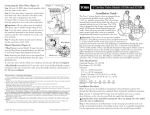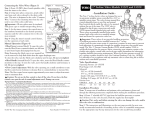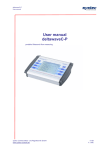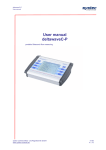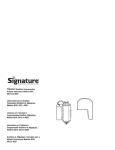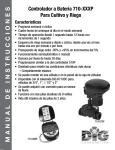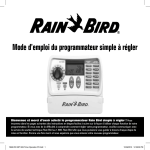Download Rain Bird DASASVF100 Instructions / Assembly
Transcript
ANTI-SIPHON VALVE OPERATION MANUAL: DAS-075 / ASVF 3/4” DAS-100 / ASVF 1” For use with all standard sprinkler controllers with 24 volt AC output. The DAS / ASVF valves are diaphragm anti-siphon valves with flow control and atmospheric vacuum breaker. NOTE: These Rain Bird valves are designed for use with static water pressures of a MAXIMUM of 150 PSI. For higher pressures, a pressure regulator should be installed. These valves are for outdoor watering use only. For dirty water systems-using wells, lakes, ditches, etc. for your water supply, be sure to install a 100 mesh (or finer) wire filter or screen filter before the electric valves. For use in cold water, less than 110°F (43.3°C), applications only. ANTI-SIPHON VALVES FOR BACKFLOW PREVENTION The DAS/ASVF models meet or exceed most building code requirements for connecting a sprinkler system to a city water supply. #1 These valves prevent the possibility of back siphoning of water from sprinkler lines into the drinking water. Wires to Controller Test this connection for water tightness before attaching outlet pipe. The anti-siphon valves must be installed at least 6 inches above the highest sprinkler or elevated piping in the circuit to meet most codes, (See Diagram 1). (Consult local building code.) CAUTION: Do not use this anti-siphon valve as a main line backflow device, nor as a master valve. It is not designed nor approved to be under constant water pressure on both sides of valve. This valve must not be operated continuously for more than twelve (12) hours. Do not install any other valves down stream. If installed incorrectly with constant pressure on both sides of valve, it is possible that the valve will fail or burst. 6” 6” The valve must be mounted at least six inches above the highest sprinkler on the circuit. Outlet to Sprinklers Inlet HOW TO SELECT THE RIGHT VALVE SIZE The valve size (3/4" or 1 ") is determined by the water flow (measured in gallons per minute, or GPM) of the main line or the sprinkler circuit. 3/4" VALVES: 13 GPM or less. 1" VALVES: 14 GPM or more. 1 " valves and pipes allow longer runs and more sprinkler heads per circuit, as well as potentially reducing the total number of valves required. ASSEMBLY OF SPRINKLER VALVES TO PIPE A sprinkler system is made up of one or more groups of sprinklers (called circuits) each operated by its own control valve. Study the illustrations and follow the instructions for proper assembly. 1 1. Before connecting and testing the assembly, thoroughly flush the main line to prevent debris from damaging the valves. 2. On the inlet side of the control valve, use galvanized steel pipe or thick-walled, Schedule 40 PVC, white plastic pipe, as this pipe is under constant pressure. On the outlet side of the control valve, thin-walled PVC pipe or flexible potyethylene pipe may be used. 3. To assure a watertight connection, use only one to two turns of Teflon tape on the threaded valve-to-pipe connections. DO NOT USE PIPE SOLVENT (CEMENT) OR PIPE DOPE. THIS MAY DAMAGE THE VALVE. DO NOT OVER-TIGHTEN. Screw adapters into place finger tight. Tighten adapters one to two additional turns. 4. Install a master shutoff valve before all electric valves, so that the water can be conveniently turned off if a valve needs servicing. TO OPERATE YOUR VALVE ELECTRONICALLY, BE SURE THE SOLENOID IS TURNED ALL THE WAY TO THE CLOCKWISE POSITION. CONNECTION, TESTING AND WIRING THESE VALVES 1. Shut off the water main or the master shutoff valve and connect the valve or valve assembly to the main supply pipe. Be sure the water lines are flushed and clean. 2. Test the pipe and valve connections for water tightness as follows: A. Turn the flow control clockwise (down) to off before turning on the water supply. B. Turn on the water and check for leaks. 3. Now complete the hookup by connecting the outlet pipes from the valves to the sprinklers. 5. When grouping valves, allow sufficient spacing between valves to unscrew the valve from the pipe (about 6 inches). 6. Do not connect the outlet side (piping to sprinkler heads) without first testing for leaks. If the outlet side is connected and there is a leak, the pipe would have to be cut in order to tighten the connection. 4. Set flow control adjustment before making wiring connections. 5. WIRE CONNECTIONS (Diagram 2). Use 18 gauge wire to connect the wires to the controller. Wiring that is to be buried alongside the pipes should be APPROVED for UNDERGROUND use. For all splices, use water tight connectors. (Do not exceed 600 ft.) VALVE OPERATION Each valve has two wires. Either one may serve as the “HOT” wire which is connected directly to a station output terminal in the controller. The other wire is "COMMON" and may be joined to the common wires of other valves with one wire running to the common terminal of the controller. Check operation using the controller. Your Rain Bird valve offers two features with which you should become familiar. FLOW CONTROL: This feature allows you to control the amount of water going to your sprinklers. To allow more water through the valve, turn the black knob counter clockwise UNTIL RESISTANCE IS FELT. This is fully open position. To reduce the amount of water, turn the black knob clockwise. If you keep turning, you can turn the valve all the way off. In this case, the valve will not open. #2 Controller Terminals Common MANUAL CONTROL: This allows you to override your automatic controller and turn your sprinklers on AT THE VALVE. The valve can be turned on manually with the external bleed screw or with the internal solenoid bleed. The solenoid (block cylinder with wires) is wired to your controller and turns the valve off and on electronically. Common Wire To operate manually with the internal bleed, turn the solenoid 1/4 turn counterclockwise; this opens the valve. The sprinklers will continue to run until you turn the solenoid back in the clockwise direction(snugly), but do not over-tighten. Valve Solenoid To turn on (open) the valve with the external bleed, turn the external bleed screw counterclockwise, 1/2 turn. Water will exit the external bleed while the valve is on. To turn off the valve, turn the external bleed screw clockwise until snug. Do not over-tighten. 2 4 3 Hot Wires 2 1 4a. Diaphragm filter clogged. Use manual, external bleed to flush valve. If this does not improve operation, remove top of valve (6 screws). Remove diaphragm and inspect filter for debris. (Check 4b at the same time.) Clean diaphragm filter and reassemble valve. REPAIR KITS Two types of repair kits are available (Diagram 3) 1. 2. SRK-ASV Solenoid Replacement Kit. The SRK-ASV will replace a defective solenoid on models DAS075/ASVF and DAS-100/ASVF. 4b. Diaphragm/valve seat fouled or damaged. Remove diaphragm and inspect diaphragm and valve seat for damage or debris. Clean or replace diaphragm and reassemble valve. B. Valve Won't Turn On Manually DRK-ASV Diaphragm Replacement Kit. The DRKASV will replace a defective diaphragm on models DAS-075/ASVF and DAS-1 00/ASVF. For technical assistance call us at 1-800-RAIN-BIRD. 1. Flow control turned off. Check by turning black knob counterclockwise until encountering resistance. Do not force beyond point of resistance. Turn knob back clockwise, approximately one half turn. 2. Water supply off at meter or system control shut-off. (Check this first by manually bleeding the valve with either bleed screw or by turning solenoid counterclockwise). 3. Blocked ports. If valve will turn on with manual, external bleed screw but NOT by turning the solenoid for internal bleed, remove the solenoid (rod check solenoid cavity for debris. Visually check small square hole at edge of cavity and carefully run a straightened wire through the center round hole to clear tube of possible debris. Take care not to scratch sides of center port tube as any change in size can affect valve operation. #3 Solenoid Replacement Kit SRK-ASV Part # 170277 Diaphragm Replacement Kit DRK-ASV C. Valves Won't Turn on Electronically (with controller) 1. Controller settings incorrect. Check programming, start times, run times and day schedules. 2. If none of the valves are working, check the common (ground) wire for a tight connection or damage. If only one or part of the valves do not work, check wiring for damage (staples, nails, cracks) between controller and valve location. 3. Check all of reasons in Section B. 4. Faulty solenoid. Turn off water supply. Switch solenoid with one from a nearby operational valve. If original valve works with second solenoid, replace original solenoid. (Install water-tight wire connections on all valves at this time to avoid future solenoid shorts and/ or failures.) 5. Controller not supplying power to valve/valves. Check fuse. If blown, replace fuse with same size. (Do not change sizes. A different size fuse will damage controller during operation and will void the warranty.) If fuse is OK, either use a volt/ohm meter to check controller output (24 VAC) at each terminal screw (station/ valve connection) OR disconnect an operating solenoid from a valve and take it to the controller. Attach one wire to the "C" terminal (common/ground) and attach the other wire to the station which is not working. Activate the controller in manual start. The solenoid should click (pull the plunger up into the solenoid tube) and it may hum. (Continued on next page) TROUBLESHOOTING GUIDE A. Water Won't Shut Off (seeping or full flow) 1. Incorrect controller setting (check length of run time) 2. Loose solenoid (should be tight) 3. Loose bleed screw - check and tighten (finger tight only) 3 5. (Continued) If nothing happens, (and the controller is still under warranty) you should either return your controller to the store or call your installer. If it's no longer under warranty, you will need to purchase a new controller. Be sure to install water-tight connectors on your wiring and a surge protector (if you live in areas highly prone to lightning). This will help to avoid future problems. APPROVED VALVE GROUP INSTALLATION USING PVC PIPE AND FITTINGS Diaphragm Automatic Anti-Siphon control valves Connecting pipe from water source Service Line to House Install valves at least 6” above the highest sprinkler PVC Pipe Service Line from Street To backyard control valves To Control Valves Connecting pipe and fittings to be the same size as the largest control valve in the group Shutoff Valve Compression Tee Water Meter To Sprinklers Call 1-800-RAIN-BIRD We’re Here to Help Customer Support Center u 6991 East Southpoint Rd., Bldg. #1 u Tucson, AZ 85706 1-800-RAIN-BIRD u (520) 434-6290 FAX ® Registered Trademark of Rain Bird Sprinkler Mfg. Corp. © Copyright 1994 Rain Bird Sprinkler Mfg. Corp. 11/94 4




